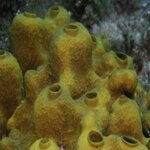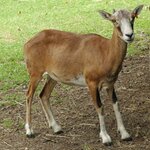Evolution

An international research team of scientists from UC Riverside, the Massachusetts Institute of Technology, Geoscience Australia, the University of Newcastle upon Tyne, the California Institute of Technology and the University of Nottingham, United Kingdom has found the oldest evidence for animals in the fossil record.
The researchers examined sedimentary rocks in south Oman, and found an anomalously high amount of distinctive steroids that date back to 635 million years ago, to around the end of the last immense ice age. The steroids are produced by sponges – one of the simplest forms of…
Show Me The Science Month Day 8
A tuatara may look like an iguana, but it's a reptile in a category all its own. Tuataras are most closely related to lizards and snakes, but in some ways they are oddballs among reptiles, with unique characteristics among reptiles, like their affinity for cool weather, their nocturnal lifestyle, a third eye on top of the skull, and vertebrae that more closely resemble those of fish and amphibians than reptiles. Male tuataras also have another odd feature - they lack a certain member, which means their reproductive behavior differs from other lizards.
Image…

Evolution may be viewed as a controversial subject by much of the US population, but evolutionary biologists frequently complain that this controversy is manufactured by opponents of evolution who have a very flawed understanding of what the science of evolution is. This poor grasp of the science was demonstrated once again in a talk given by Intelligent Design advocate Jonathan Wells, who claims that "DNA does not control embryo development."
Wells, who has a PhD in biology, (I don't know what the director of graduate studies at UC Berkeley was smoking), has repeatedly demonstrated his…

Two newly described fossil whales---a pregnant female and a male of the same species--reveal how primitive whales gave birth and provide new insights into how whales made the transition from land to sea.
The 47.5 million-year-old fossils, discovered in Pakistan in 2000 and 2004 and studied at the University of Michigan, are described by U-M paleontologist Philip Gingerich, who led the team that made the discoveries, was at first perplexed by the assortment of adult female and fetal bones found together. "When I first saw the small teeth in the field, I thought we were dealing with a small…

Show Me The Science Month Day 7
The birth of new species always involves a barrier to cross-breeding between two different groups of the same species. This barrier may start out as a geographical barrier (two raccoon populations on different sides of a mountain never encounter each other and thus fail to interbreed), but however it starts, reporductive barriers always turn into a genetic barrier. To form new species, two populations of organisms have to drift apart genetically.
The genetic split can happen in a variety of ways, as scientists are discovering in the their quest to find '…

If you have not already chosen your new love, researchers suggest you stay away from those with big chins as they have a tendency to cheat. Researchers from four universities across the US and Canada prodded into the sexual habits of chinny and relatively chin-less females to determine these results.
Kidding? No, they’ve published in the journal Personality And Individual Differences, so it must be true. Larger chins, especially on adult females, are associated with the male growth hormone testosterone and too much of that bad boy can lead to messing around. It seems on an subconscious level…

Show Me The Science Month Day 6
Yesterday we discussed the discovery of a gene that keeps mouse subspecies from producing fertile hybrid offspring. In other words, a gene that is putting a reproductive barrier between incipient mouse species.
Scientists have discovered speciation genes in other organisms as well. A report by Nitin Phadnis and H. Allen Orr at the University of Rochester describes a speciation gene that puts a reproductive barrier between fruit fly subspecies.
As with the mouse gene, this fruit fly speciation gene, called overdrive, causes sterility between two subspecies. Two…

Show Me The Science Month Day 5
Speciation Genetics is, in a sense, an oxymoron. Genetics is the study of heritable characteristics, but the researchers who study speciation genetics are looking for genes that cause inheritance to fail. They are looking for the genetic incompatibilities that keep species apart.
Speciation is about how a population of similar, interbreeding organisms becomes two or more populations so different from each other that they no longer form a common gene pool. Species' differences can be extremely subtle. In fact, an evolutionary process of speciation means that…

The alumni magazines that come to my house rarely get much more than a quick glance, but this month the Rochester Review has an interesting interview with H. Allen Orr, one of the leading evolutionary biologists working in the field of speciation. Orr is about to receive a major prize in the field, the Darwin-Wallace medal. The alumni magazine used this occasion to get Orr to explain why Darwin matters, and how genomic technologies are changing the field:
Darwin lived in the age of discovery. People were going out on those voyages and sending all these bizarre organisms back to London or back…

Looking for more evolution blogging? Check out the eighth edition of Carnival of Evolution at Biochemical Soul. There is great stuff on fossils, genes, parasites, antibiotics, and Darwin, so head on over for a visit.